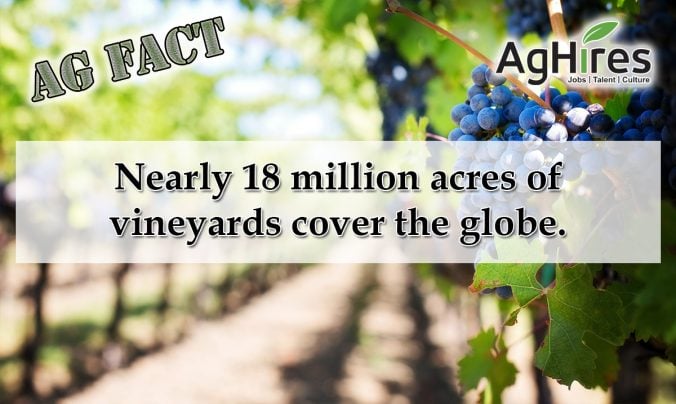
May 25th is National Wine Day! Without grapes, we wouldn’t have wine! Currently, over 1,300 grape varieties are being used to make wine around the world. Nearly 18 million acres of vineyards cover the globe. While we have been cultivating grapes for 8,000 years, it is believed that grapes have been around for over 65 million years. Archeologists believe grapes are native to Eastern Europe and have spread from there.
Spain, China, France, Italy, Turkey and the U.S. are the top growing countries. However, France, Italy, Spain, the United States, and Argentina are the largest producers of the beverage. California is the 4th largest producer, following France, Italy, and Spain. In 2014, the U.S. produced just over 830 million gallons, while France produced 1.2 billion gallons. Washington and New York follow California in production in the U.S.
Best Grapes for Drinking
Grapes used for wine have a much thicker skin than the grapes we’re used to buying at the grocery store. Green grapes make the white wines, while the purple or blue grapes make the reds. However, the skins and other parts of the grapes are what makes the beverage red, as well as give it a bolder taste.
The Soil Makes a Difference
The region where the vineyard grows their grapes plays an important role in the type of wine. Soil nutrients, sunshine, temperature, moisture, fog, and other conditions all affect the flavor.
Sandy soils produce less acidic wines, while clay produces deep bold flavors and loamy soils produce flavorless wines. Grapes produced in warm climates make sweeter wines and cooler climates create tart wines.
Planting to Wine
Once planted, it takes 3 years for the grape vine to produce fruit. In California, vine begin to bud in March and fruit sets usually being in May. Veraison, when the hard, green grapes transform into plump, juicy clusters, happens in late July.
The order in which grapes are harvested depend on the type of wines they are grown for. Grapes for the sparkling variety are harvest the earliest, followed by grapes for Chardonnay and Sauvignon Blanc, then Pinot Noir, Merlot, and Malbec, and finally Cabernet Sauvignon and other robust reds. Initial Fermentation can take up to a month. Aging and Malolactic Fermentation depends on the type of wine.
Other facts:
- There is a winery in every state in the USA.
- While sparkling wine can be produced anywhere, only grapes grown in the Champagne region of northeast France can be called Champagne.
- Research shows that white wines keep lung tissues healthy.
- Red wines should be served in glasses with a larger bowl, so the bold aromas and flavors can emerge through mingling with oxygen in the air.
- The “birthplace of wine” is the country of Georgia.
Want more Agriculture Facts? Click here
Follow us on Facebook and Twitter to get your weekly dose of Ag Facts.
Sources:
Wine Institute
Napa Valley: Basic Wine Facts
Wine Cooler Direct: Life Cycle of a Wine Grape






